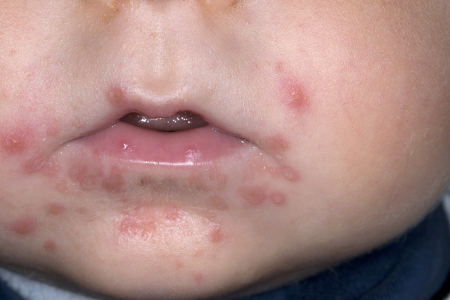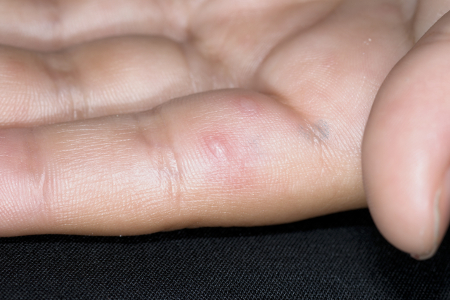Approach
This is a minor illness causing only a few days of fever and relatively mild signs and symptoms. Diagnosis is usually clinical, based on a typical history and characteristic clinical features. Testing is not typically warranted unless exposure to enterovirus 71 (EV71) is a possibility. EV71 causes a more severe illness and requires greater vigilance to detect complications early.
History
In most cases, the patient is <10 years of age and presents with a sudden onset of low-grade fever, loss of appetite, sore throat, cough, abdominal pain, diarrhea, and general malaise. Arthralgia occurs occasionally. This prodromal period may last 3 to 4 days and is typically followed by sores appearing on the oral mucosa. Rash on the palms of the hands and soles of the feet and on the buttocks can follow within 1 or 2 days. The disease may cause all of the above signs and symptoms or just a few of them.
Physical exam
The oropharynx is inflamed, with scattered papules, macules, vesicles, or ulcers on an erythematous base present on the tongue, pharynx, buccal mucosa, gingiva, and occasionally the lips. If the child presents late, only yellowish ulcerations will be seen, as vesicles tend to rupture quickly. The ulcers are 4 to 8 mm in size and may be sharply marginated. Lesions do not usually involve the soft palate, and generalized ulceration in the mouth is unusual. Erythema and edema of the tongue may also occur.
There is usually an acral rash involving the palms and soles, with small oval or linear gray-white vesicopustules. The vesicles are flaccid and thin-walled, with an erythematous halo. They may occasionally be painful or pruritic. They tend to ulcerate and become crusted. Lesions heal within 1 week. A maculopapular rash may be seen on the buttocks.[13] Younger children tend to have all the features, whereas older children may have only the oral lesions or the acral lesions.
[Figure caption and citation for the preceding image starts]: Hand, foot and mouth disease. Rash around the mouth of a 1 year old boy with hand foot and mouth disease (HFMD). HFMD is caused by intestinal viruses of the picornaviridae family. The most common strains causing HFMD are coxsackie A virus A16 and enterovirus 71 (EF-71).Dr P. Marazzi/Science Photo Library [Citation ends]. [Figure caption and citation for the preceding image starts]: Hand, foot and mouth disease. Close-up of a blisters (known as vesicles) on the hand of a 3 year old boy with hand foot and mouth disease (HFMD). HFMD is caused by intestinal viruses of the picornaviridae family. The most common strains causing HFMD are coxsackie A virus A16 and enterovirus 71 (EF-71).Dr P. Marazzi/Science Photo Library [Citation ends].
[Figure caption and citation for the preceding image starts]: Hand, foot and mouth disease. Close-up of a blisters (known as vesicles) on the hand of a 3 year old boy with hand foot and mouth disease (HFMD). HFMD is caused by intestinal viruses of the picornaviridae family. The most common strains causing HFMD are coxsackie A virus A16 and enterovirus 71 (EF-71).Dr P. Marazzi/Science Photo Library [Citation ends].
In EV71 infection, the rash may be more papular, with petechiae. Also, diffuse areas of erythema may be seen on the trunk and limbs. In addition, vomiting and a high fever of >102.2°F (>39°C) lasting >3 days are more common, with accompanying headache and irritability. Infection with this virus is more severe, with a significantly greater frequency of serious complications and fatality.[7][8][9][10]
Laboratory tests
Laboratory testing may be necessary and helpful if exposure to EV71 is a possibility, such as with recent travel to East or Southeast Asian countries. To identify the causative virus, culture from stool or vesicle fluid is preferred, although a throat swab may also be used. PCR molecular assays can rapidly distinguish between coxsackievirus A16 and enterovirus 71, but these are not widely available. Complete blood count is not needed routinely, but if done will reveal an elevated white blood cell count and atypical lymphocytes.
Use of this content is subject to our disclaimer